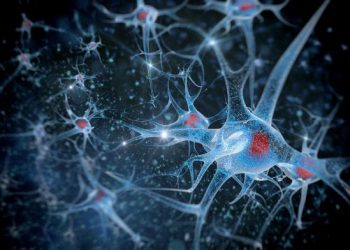People with CML have a short chromosome, called the Philadelphia chromosome, named after the city where it was first discovered. This chromosome gives instructions to make an abnormal protein, BCR:ABL1.
Medicines that target this protein often put patients into remission. This is usually followed by a blood or bone marrow transplant (BMT). BMT replaces unhealthy blood-forming cells with healthy ones.
Causes
Each cell in your body has a set of 46 chromosomes that contain the DNA that gives instructions for how your cells grow and develop. A change (mutation) in one of these chromosomes, called the Philadelphia chromosome, causes some blood stem cells to turn into cancerous white blood cells that don’t stop growing. These cells build up in the blood and bone marrow, crowding out healthy cells such as red blood cells and platelets, which help the blood clot. This overgrowth causes the spleen to get bigger, and it can lead to symptoms such as fever, night sweats, weight loss and fatigue.
Most people with CML have an acquired genetic mutation in the BCR-ABL oncogene, which isn’t present at birth and can’t be passed from parent to child. They develop it over time, probably during their lifetime, in the myeloid stem cells in their bone marrow. The BCR-ABL oncogene acts like a switch that turns on (activates) leukemia cells to keep them growing. These cells can form leukemia in the blood and bone marrow, but they also can spread to other parts of the body.
The mutated myeloid stem cells can eventually become immature white blood cells, or blasts, that don’t stop growing and don’t mature into the normal types of blood cells needed for growth and repair. These abnormal cells can cause infections, and they can prevent healthy blood-forming cells from developing in the bone marrow, so there isn’t enough room for normal white blood cells, red blood cells and platelets. When the number of blasts gets too high, the disease moves into an accelerated phase and then into blast crisis, which has more serious symptoms such as fever, night sweats, loss of appetite, swollen belly (abdominal distention), weight loss and fatigue, easy bruising and bleeding, a feeling that you’re full even when you haven’t eaten and an enlarged spleen.
The first step in treatment is to try to reduce the number of blasts. Doctors use tests such as a complete blood count and a bone marrow aspiration or biopsy to see how many leukemia cells are in the blood and bone marrow. They may also do a CT scan or ultrasound to look for an enlarged spleen. Doctors usually start with medicines called tyrosine kinase inhibitors (TKIs), such as bosutinib (Bosulif) and ponatinib (Iclusig). These drugs block the protein that the Philadelphia chromosome makes and slow down the rate at which leukemia cells are made. They may add chemotherapy to kill cancerous cells and replace them with healthy blood-forming cells.
Symptoms
The cancer develops from an acquired genetic mutation or change in myeloid stem cells. These are the cells that form blood cells such as red cells, white cells and platelets. The abnormal gene BCR-ABL stimulates these immature white blood cells to grow and multiply out of control, crowding out healthy red cells and platelets. This also leads to an enlarged spleen. The symptoms of CML gradually build up over time and can be very severe. People often don’t feel sick and learn they have the condition after routine blood tests show abnormal blood cell counts. If they don’t get prompt treatment, the disease progresses to a more aggressive phase and is life-threatening within three to four years.
The American Cancer Society explains that most cases of CML result from a chromosome translocation. This means that two different chromosomes — 9 and 22 in most people with the disease, but not all — get swapped. This changes the DNA code in those chromosomes, creating a new gene that acts like a switch. The abnormal BCR-ABL turns on a type of white blood cell called granulocytes to overgrow and multiply. Over time, this can crowd out healthy red and white blood cells and platelets, leading to the symptoms of CML.
Doctors use a number of tests to diagnose CML. They measure the number of immature white blood cells, called blasts, in your blood and bone marrow. They may also look at the chromosomes in your blast cells to find out what other changes they have. Your doctor will decide what stage you are in based on the results of these and other tests.
Your doctor will also look for other signs of the disease, such as a spleen that is enlarged and a low level of the blood-clotting protein, platelets. A spleen that is enlarged can cause an abdominal feeling of fullness, fatigue and weight loss. The lack of platelets can cause easy bruising, nosebleeds and bleeding gums. It can also lead to very heavy periods in women.
The three phases of CML are chronic, accelerated and blast. In the chronic phase, which is present at diagnosis in about 85% of people with CML, you have less than 10% blast cells in your blood and bone marrow. The accelerated phase is characterized by increased blast cells and other chromosomal changes and does not respond as well to chemotherapy drugs as the chronic phase. In the blast phase, you have more than 20% blast cells in your blood and bone marrow. This phase is very similar to acute leukemia, and it can lead to severe symptoms including bleeding problems such as nosebleeds, very heavy periods or a fine rash of red spots (petechiae).
Diagnosis
Diagnosing CML usually starts with a blood test called a complete blood count (CBC). This counts the number of different types of cells in your body. People with CML have an abnormally high number of immature white blood cells, called blasts. Sometimes these blasts can be seen in the bone marrow or blood sample under a microscope. A hematopathologist, a specialist in blood cell diseases, can confirm the diagnosis of CML by examining your blood and bone marrow samples. A hematopathologist can also tell you what phase your disease is in.
Most people with CML are diagnosed in the chronic phase. At this stage, the blast percentage in their blood and bone marrow is lower than 10%. Chronic phase CML can be controlled with standard treatment that reduces the number of leukemia cells. This type of treatment can put people into remission, which can last for years.
Blood and bone marrow tests can help doctors determine the phase of your disease and which treatment is best for you. You may also need special tests that check for the Philadelphia chromosome or the BCR-ABL oncogene. These can be done on a sample of your bone marrow or blood, or with a special test that looks at the chromosomes in your cells.
Another way to diagnose CML is by comparing your blood and bone marrow samples with the results of other patients with your same phase. This can be done by using a process called fluorescence in situ hybridization or polymerase chain reaction.
The chromosome mutation that causes CML is only found in a small number of cases. For most patients, their increased blood cell counts and other symptoms are enough to suspect CML. They can be tested for the presence of the Philadelphia chromosome and the BCR-ABL oncogene, which will confirm a diagnosis.
Doctors treat people with CML in one of three phases: chronic, accelerated or blast crisis. The goals of treatment are to relieve symptoms, stop the cancer from moving into the accelerated or blast phases and, in the case of a blast crisis, to return your blood cells to the chronic phase. You might need targeted therapy, chemotherapy or a stem cell transplant to do this. In addition to treatment for the leukemia, you will need palliative care to ease pain and other problems.
Treatment
When you have CML, your doctor may give you a drug called imatinib (Gleevec). The goal is to treat you until there’s no evidence of leukemia in your blood or bone marrow. This is known as achieving a complete cytogenetic response, and it means you have no Philadelphia chromosome-positive cells in your blood or bone marrow. A new drug, dasatinib (Sprycel), is also available for treating CML. It works the same way as imatinib does, but it’s a little more powerful. New drugs, such as bosutinib (Atezolizumab) and ponatinib (Sprycel), are being studied to see how well they work.
These drugs, which work by targeting the BCR-ABL tyrosine kinase enzyme, can control the growth of cancer cells and stop them from dividing. This gives healthy blood-forming cells a chance to grow and replace the ones that are growing out of control. It’s not clear if these drugs can cure CML, but they help many people with this disease stay in remission for years.
If you’re in the chronic phase of CML, you’ll continue to get treatment to control the disease and delay complications. During this time, your doctor will check you regularly with blood tests and a physical exam. He or she may feel your lymph nodes, spleen, and abdomen for any swelling.
You might also be given a medication called hydroxycarbamide, which lowers the number of white blood cells and platelets in your body. Your doctor might also prescribe a medicine called allopurinol to prevent gout, which is a side effect of this drug.
Some people with chronic myelogenous leukemia have a bone marrow transplant from a family member, an unrelated donor, or an umbilical cord blood donation. During this procedure, your doctor puts replacement blood stem cells into your body to replace the damaged ones. Then, chemotherapy or radiation is given to kill the cancerous stem cells and any other cancerous cells in your blood and bone marrow. Then the donated stem cells are returned to your marrow and begin making healthy blood-forming cells.
There are 2 types of transplants used for CML based on the source of the replacement blood stem cells: allogeneic and autologous. Both have their own risks and benefits. Many people have a successful transplant with only minor side effects, but the disease can return. Talk to your doctors about the chances of the transplant working for you and the risks that it might not.









